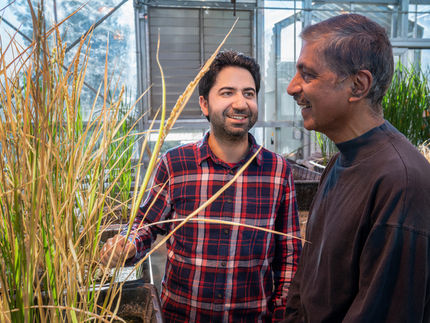Controlling the flower architecture of barley
New ways to increase yields: researchers identify key to more grains
Advertisement
How the flowering of grasses - including barley - looks is controlled by "meristems", which are home to the stem cells of the plants. Biologists at Heinrich Heine University Düsseldorf (HHU) have now identified a specific peptide and the associated receptor that determine the growth of inflorescences in two axes. In a study published in the journal Nature Communications, they explain that the number of barley grains formed also depends on this.
Grasses have developed many different forms of inflorescences. How the grains are arranged in them varies: some species form complex, branched inflorescences that bear several grains; others, such as barley, have much simpler inflorescences. In barley, the individual grains are each formed on a short axis, the "rachilla".
These differences in flower architecture are created early on during plant development. The size, position and lifespan of the meristems determine how the inflorescence is ultimately formed.
A team of scientists led by Prof. Dr. Rüdiger Simon from the Institute of Developmental Genetics at HHU has now discovered a signaling pathway that regulates the activity of certain meristems in barley. In Nature Communications, they describe that a small peptide secreted by rachilla cells called HvFCP1 interacts with a receptor called HvCLV1 localized on the plasma membrane and thus controls the growth of the meristems along the vertical and horizontal axes. This ultimately determines the shape of the barley inflorescence.
The researchers also investigated what happens when the genes responsible for the formation of HvFCP1 or HvCLV1 mutate. In these cases, the plants develop enlarged inflorescences and rachises. The inflorescences of these barley mutants - with the formation of several flowers (and later grains) from one rachilla - then resemble the inflorescences of wheat in their architecture.
In their research, the study authors combined a gene function analysis at the cellular level with a detailed phenotypic characterization using scanning electron and fluorescence microscopy. Prof. Simon: "HHU is excellently equipped for this thanks to its microscopy center, the Center for Advanced Imaging (CAi)."
The first author of the study, Dr. Isaia Vardanega, says: "Our discovery now enables us to redesign the inflorescences of grasses. By understanding the stem cell system of barley in more detail, we can, for example, increase the number of grains and thus contribute to higher agricultural production."
Prof. Simon adds: "This work lays the foundation for new, targeted breeding approaches. Our knowledge of the genetic control of barley architecture will make it possible to produce new and high-yielding plant varieties more quickly with the help of genome editing."
Note: This article has been translated using a computer system without human intervention. LUMITOS offers these automatic translations to present a wider range of current news. Since this article has been translated with automatic translation, it is possible that it contains errors in vocabulary, syntax or grammar. The original article in German can be found here.
Original publication
Isaia Vardanega, Jan Eric Maika, Edgar Demesa-Arevalo, Tianyu Lan, Gwendolyn K. Kirschner, Jafargholi Imani, Ivan F. Acosta, Katarzyna Makowska, Götz Hensel, Thilanka Ranaweera, Shin-Han Shiu, Thorsten Schnurbusch, Maria von Korff, Rüdiger Simon; "CLAVATA signalling shapes barley inflorescence by controlling activity and determinacy of shoot meristem and rachilla"; Nature Communications, Volume 16, 2025-4-26




























































